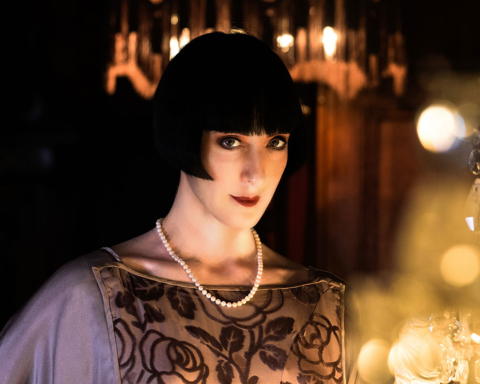Edward Sexton was the trailblazer of traditional British tailoring who rescued the image of Savile Row not once, but twice, writes Freddie Anderson.

Edward Sexton’s journey of changing the suiting folklore of Savile Row began on Valentine’s Day in 1969. With business partner Tommy Nutter, they originally used the appellation of Nutters of Savile Row. Nutter was a whirlwind of charm, eccentricity and good looks who died aged 49 in 1992 from complications arising from AIDS. While Nutter was a social lightbulb and coaxed in a likeminded avant-garde customer, it was Sexton who was the talent in the workroom with his outstanding creative workmanship.
Born in 1942 in Dagenham, then a municipal borough of Essex, Sexton’s working-class Catholic family, some of whom worked as tailors and seamstresses, formed an indelible impression on Sexton’s future vocation. Aged 15, Sexton started to take holiday jobs at his uncle’s dressmaking workshop, where he used to deliver trousers to the stores they were working with. It gave him a valuable foundation to turn his hand to bespoke garments.
Originally working at the formidable military tailors Welsh & Jefferies as a junior cutter, Sexton then transferred to Kilgour, French & Stanbury, famously the makers of the blue-grey single-breasted Glen check suit worn by Cary Grant in the Alfred Hitchcock’s film North by Northwest (1959). But it was during his stint at Donaldson, Williams & G. Ward in Mayfair’s Burlington Arcade that he exerted his inner stylistic traits. This was partly aided by a rebellious alliance with workfellow Tommy Nutter, with whom Sexton instantly clicked. At this time Sexton was moonlighting as a private tailor to some fairly lively East End gangsters, while the charismatic Nutter was sauntering into haunts populated with daring young rock ‘n’ roll stars and encouraging their desire for edgy yet flawless garments.

The truth was that Savile Row didn’t endorse or respond to the youth-driven cultural revolution of the Swinging Sixties. Many of the individuals that represented this defining counterculture were young musicians, actors, and artists who were pining for the faultless craftsmanship of Savile Row mixed in with the risqué street fashion displayed by the Mods on Carnaby Street. The upper crust of society was now not the only people with the means to fill their wardrobes with bespoke items made on the famed Row. With backing from a variety of broad-minded disciples including Peter Brown (The Beatles’ music manager), Cilla Black (singer and television presenter), and James Vallance White (barrister in The House of Lords), Nutter’s of Savile Row was launched at No 35a Savile Row – the first new company to be established on the renowned street in over 100 years – on 14th February 1969.
Sexton possessed that rare ability to respond to change with his celebrated rebellious design nature. Nutters captured the style zeitgeist that swinging London was yearning for, and in turn, by operating out of their own premises on the Row it positively disrupted the staid sartorial reputation the Row had become stuck with. Aside from Sexton’s archetypal design details, including architectural shoulders, suppressed waist, elongated trouser silhouettes and the famous wide peak lapel, their shop window was decorative dynamite. No other tailoring establishment had the temerity to operate with an embellished front window – never mind one bedecked with pink ostrich feathers or dinner jackets hanging from suspended trashcans.

When people think of the 1970s they think of Bianca Jagger on a white horse in Studio 54; the fact that Nutters of Savile Row were appointed to cut Mick Jagger’s and Bianca Pérez-Mora Macias’s wedding suit in 1971 only goes some way in emphasising the breadth of their influence on popular culture. Arguably their most iconic contribution had manifested the previous decade. They dressed three of The Beatles for the photograph of their emblematic stroll across a zebra crossing on the Abbey Road album cover. Justin de Villeneuve, Twiggy, David Bowie and Paul McCartney were early and enduring clients. As demonstrated by the aforementioned suit worn by Bianca Jagger, Sexton was equally adept at outfitting ladies. Cindy Crawford, Yasmin Le Bon and Naomi Campbell were three supermodels that sourced Sexton’s distinguished suit-making skills.
Right until the end, Sexton outfitted the music world’s sartorially inquisitive, not least singer Harry Styles. The bespoke peony pink suit worn on Styles’s global live tour in 2017 is just one of many suits that the singer commissioned Sexton to create. Around this time, the master tailor told The Rake of the Sexton look: “Tremendously elegant – edgy but elegant… sophisticated, but totally revolutionary.” In 2017, the Sexton brand added a new string to its bow in the form of ready-to-wear collections. This was in part due to the increasing demand for their products to be bought via e-commerce channels, which continues to go from strength to strength under the firm’s abiding creative director, Dominic Sebag-Montefiore.

However, when digitalization was still in its infancy in 1976, Nutter and Sexton split as co-proprietors of Nutters of Savile Row. Sexton took over the business, and during the early 1980s he renamed the house in his own name. In the ensuing decade, Sexton set up an atelier in Beauchamp Place, Knightsbridge, closing his brick-and-mortar establishment on Savile Row. In 2020 he retraced his steps by returning to 35 Savile Row after a near 30-year absence. Invited by Pollen Estates, which owns swathes of Savile Row to help safeguard the legacy of the street, at the age of 78 Sexton was also personally itching to respond to the general decline of sartorial innovation. And he did, injecting into the Row a sense of stylistic insurgency with his creations. There were new linen suits in bold colours, signature ’80s-inspired shirting and revamped black-tie – all of which embodied those trademark Sexton idiosyncrasies.
Aside from Sexton’s inventiveness and unparalleled craftsmanship, he was an inquisitive and kind man. I experienced this first-hand one day at the Grand Seiko boutique, then in Knightsbridge. Attending a party to celebrate the collaboration between Revolution magazine and Grand Seiko, we got chatting. He commented on my suit, which was adorned with a Tommy Nutter label, and kindly invited me to visit him at Beauchamp Place for further inspection. What a privilege it was to converse with the master tailor in his own habitat. Whip smart and with a memory to match, he took my lapels in his delicate hands and slowly broke into a smile. He remembered cutting that very suit – a moment that I will forever cherish.
Edward Sexton, 9th November 1942–23rd July 2023









